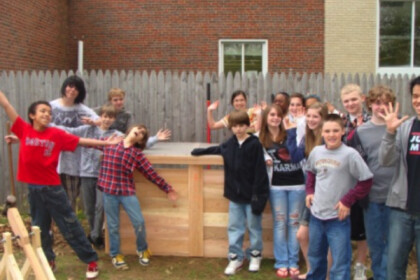
Projects & Materials

Hands-on Engineering Falmouth

Students in Bob Porto’s eighth-grade engineering class at Lawrence School in Falmouth say class is not just fun. “It is a huge amount of fun.”
One student adds that what’s important to her is that “you won’t be left out here.” Talking about his project, another student pauses. “I could talk for hours.”
This is part of why we exist as a network: to figure out what kinds of experiences get students bubbling over with enthusiasm for STEM learning. These students sure made us want to know more about their teachers’ approaches to STEM.
We’re not after a specific “method.” Because great STEM teaching is different for each teacher, student, and school. But we do want to share the inspiration that comes from seeing engineering-focused problem-solving spark real joy.
One reason Bob Porto’s class works so well is that it’s part of a holistic focus on STEM across the curriculum at the Lawrence School.
There’s the STEM Workshop, for instance, a seventh- and eighth-grade elective that is offered concurrently with the team science class. As students dig into real-world projects there, they seem to seek out their teachers’ ideas and input in ways they never did before.
Porto’s class is also supported by what goes on for students in the year before they take his class. Students in Janice Lewis’s class explore engineering—building tissue paper balloons to explore density, snap circuits as an introduction to electricity, and balsa gliders to test physical forces such as lift, thrust, and drag—all in seventh grade.
By grade eight, students are ready to roll up their sleeves and do some real-world engineering. At Falmouth, it’s striking just how real STEM can be. We watched students there wield traditional woodshop tools, building Rube Goldberg devices in a remarkably can-do way.
Maybe that’s because they know each trimester concludes with a capstone project. In the fall, there’s a Building Blitz where students build picnic tables, benches, kiosks for displays, and more for organizations and schools in Falmouth. In spring, it’s a mock Iditarod race that coincides with their ELA unit on the real thing. There is also an interdisciplinary DaVinci Dash in which students compete to design simple machines.
The Lawrence School just held its 4th Annual Lawrence Iditarod race. As always, students built the racing “sleds” themselves. They work out the mathematics and engineering of what makes a balanced-yet-speedy cart in the classroom. Then they put their designs to the test in the field, mushing and pulling their sleds around the school on a mile-long course.
Projects like these are a lot of fun. At the same time, they bring students together to work on their understanding of engineering by making it real. And that’s what Porto thinks is most important.
“Ultimately, we have been trying to help students develop teamwork and problem-solving skills that can be applied at school, at home, and in the community,” he says. “There is nothing like hearing a student at a community event say, ‘I built that.’ ”
We look forward to featuring more examples of how districts are integrating STEM into their schools and communities. Let us know what STEM teaching and learning means in yours.